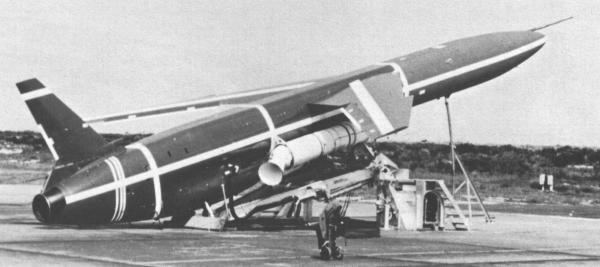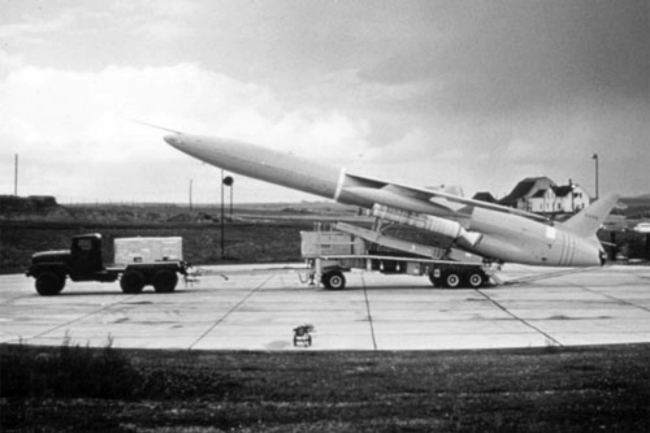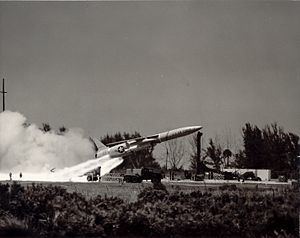Place of origin United States Produced 1958–61 Operational range 10.186 million m | In service 1959–61 Total length 20 m | |
 | ||
Weight 48,150 pounds (21,850 kilogram) without boosters; 60,000 pounds (27,200 kg) with boosters Warhead W39 thermonuclear warhead (explosive yield: 3.8 megatons) | ||
Northrop sm 62 snark
The Northrop SM-62 Snark was an early-model intercontinental range ground-launched cruise missile that could carry a W39 thermonuclear warhead. The Snark was deployed by the United States Air Force's Strategic Air Command from 1958 through 1961. It represented an important step in weapons technology during the Cold War. The Snark took its name from the author Lewis Carroll's character the "snark".
Contents
- Northrop sm 62 snark
- Design and development
- Technical description
- Operational history
- Survivors
- References

The Snark missile was developed to present a nuclear deterrent to the Soviet Union and other potential enemies at a time when Intercontinental ballistic missiles (ICBMs) were still in development. The Snark was the only surface-to-surface cruise missile with such a long range that was ever deployed by the U.S. Air Force. Following the deployment of ICBMs, the Snark was rendered obsolete, and it was removed from deployment in 1961.

Design and development

Work on the project began in 1946. Initially there were two missiles designed—a subsonic design (the MX775A Snark) and a supersonic design (the MX775B Boojum).(From the same poem: "The snark was a boojum, you see.") Budget reductions threatened the project in its first year, but the intervention of Air Force General Carl Spaatz and the industrialist Jack Northrop saved the project. Despite this, its funding by Congress was low, and this program was dogged by changes in specifications. The earliest planned due date in 1953 passed with the design still in development, and the Strategic Air Command was gradually becoming less supportive of it. In 1955, President Dwight D. Eisenhower ordered that top priority be assigned to ICBMs and their associated guided missile programs.

Despite considerable difficulties with the development of the Snark, and reservations from the Department of Defense towards it, the engineering work continued.

In 1957, tests of the Snark showed an estimated circular error probable (CEP) of just 17 nautical miles (31.5 kilometers). By 1958, the celestial navigation system used by the Snark allowed its most accurate test, which appeared to fall four nautical miles (7.4 km) short of the target. However, this apparent failure was at least partially caused by the British Navigation Charts used to determine the position of Ascension Island being based on position determinations less accurate than those used by the Snark. The missile landed where Ascension Island would be found if more accurate navigation methods had been used when developing the chart. However, even with the decreased CEP, the design was notoriously unreliable, with the majority of tests suffering mechanical failure thousands of miles before reaching the target. Other factors, such as the reduction in operating altitude from 150,000 to 55,000 feet (46,000 to 17,000 meters), and the inability of the Snark to detect countermeasures and perform evasive maneuvers also made it a questionable strategic deterrent.
Technical description

The jet propelled 20.5 meter-long Snark missile had a top speed of about 650 mph (1,046 km/h) and a maximum range of about 5,500 nautical miles (10,200 kilometers). Its complicated celestial navigation system gave it a claimed CEP of about 8,000 feet (2.4 kilometers).
The Snark was an air-breathing missile, intended to be launched from a truck-mounted platform by two solid-fueled rocket booster engines. The Snark next switched to an internal turbojet engine for the rest of its flight. The engine was a Pratt and Whitney J57, which was the first jet engine featuring a thrust of 10,000 pounds (44 kilonewtons) or more. Since the Snark lacked a horizontal tail surface, it used elevons as its primary flight control surfaces, and it flew with an unusual nose-high angle during level flight. During the final phase of its flight, its nuclear warhead would have separated from its fuselage and then followed a ballistic trajectory towards its target. Due to the abrupt shift in its center of gravity caused by separation, the fuselage would have performed an abrupt pitch-up maneuver in order to avoid a collision with the warhead.
One unusual capability of the Snark missile was its ability to fly away from its launch point for up to 11 hours, and then return for a landing. If its warhead did not detach from its body, then the Snark could be flown repeatedly. Lacking any landing gear, it would have been necessary for the Snark to skid to a stop on a flat, level surface. A runway at the Cape Canaveral Air Force Station is still known as the "Skid Strip".
Operational history
In January 1958, the Strategic Air Command began accepting delivery of Snark missiles at Patrick Air Force Base for training, and in 1959, the 702d Strategic Missile Wing was formed.
On 27 May 1959, Presque Isle Air Force Base, Maine, the only Snark missile base, received its first missile. Ten months later, on 18 March 1960, a Snark missile went on alert status. A total of 30 Snarks are known to have been deployed.
The 702nd Wing was not declared to be fully operational until February 1961. In March 1961, President John F. Kennedy declared the Snark to be "obsolete and of marginal military value", and on 25 June 1961, the 702nd Wing was inactivated.
Many in the U.S. Military were surprised the Snark, due to its dubious guidance system, was ever operational. In flight tests many were lost. A missile launched in 1956 went so far off course that it landed in North-Eastern Brazil, where it was found in 1983. Many of those connected with the program commented in jest "That the Caribbean was full of 'Snark infested waters'."
